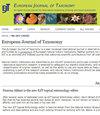Integrative taxonomy reveals unanticipated hidden diversity in the monotypic goosefish genus Lophiomus (Teleostei, Lophiidae), with description of three new species and resurrection of Chirolophius laticeps Ogilby, 1910
IF 1.1
3区 生物学
Q3 ENTOMOLOGY
引用次数: 0
Abstract
Thought to be monotypic for decades, the only species in the goosefish genus Lophiomus Gill, Lm. setigerus (Vahl), shows a wide range of morphological variation and is distributed widely in the Indo-West Pacific (IWP). In this study, datasets for two mitochondrial and two nuclear genes sequences obtained from samples of Lophiomus collected in different localities across the IWP were constructed and analyzed to explore the phylogeny and species diversity within the genus. Our integrated approach with multiline evidence unveiled an unanticipated richness of at least six delimited species of Lophiomus. Herein, based on materials already available from museums and new specimens obtained primarily through the Tropical Deep-Sea Benthos program surveying IWP benthic fauna, we formally describe three new species: Lm. immaculioralis sp. nov., Lm. nigriventris sp. nov., and Lm. carusoi sp. nov. Also, we resurrect Lm. laticeps stat. rev. from synonyms of Lm. setigerus. These species can be diagnosed by genetics, body coloration, patterns on the floor of the mouth, peritoneum pigmentation, morphometric measurements, and meristic counts of cranial spines, dorsal-fin spines, and pectoral-fin and pelvic-fin rays from each other and from Lm. setigerus. The species Lm. setigerus, as well as the genus Lophiomus, are re-described accordingly based on the new results. Amended identification keys to the four extant lophiid genera and to species of Lophiomus are also provided.综合分类法揭示了单型鹅鱼属 Lophiomus(远洋鱼类,鹅鱼科)中隐藏的意料之外的多样性,描述了三个新种并复活了 Chirolophius laticeps Ogilby, 1910
几十年来,人们一直认为鹅掌鱼属的唯一物种 Lophiomus Gill(Lm. setigerus (Vahl))是单型的,但它的形态变异范围很广,广泛分布于印度-西太平洋(IWP)。本研究构建并分析了从印度洋-西太平洋不同地点采集的 Lophiomus 样品中获得的两个线粒体基因和两个核基因序列数据集,以探索该属的系统发育和物种多样性。我们利用多线证据的综合方法发现,至少有 6 个限定的 Lophiomus 种类,其丰富程度出乎意料。在此,我们根据博物馆已有的材料和主要通过热带深海底栖生物计划调查 IWP 底栖动物群获得的新标本,正式描述了三个新物种:Lm. immaculioralis sp.此外,我们还从 Lm. setigerus 的异名中恢复了 Lm.这些物种可以通过遗传学、体色、口底花纹、腹膜色素沉着、形态测量以及颅棘、背鳍棘、胸鳍和盆鳍条的分部计数来诊断。根据新的结果,对 Lm. setigerus 这一物种以及 Lophiomus 属进行了相应的重新描述。此外,还提供了经修订的四个现存石龙子属和石龙子种的识别钥匙。
本文章由计算机程序翻译,如有差异,请以英文原文为准。
求助全文
约1分钟内获得全文
求助全文
来源期刊

European journal of taxonomy
ZOOLOGY-
CiteScore
2.30
自引率
8.30%
发文量
173
审稿时长
29 weeks
期刊介绍:
EJT is a fully refereed, international, fully electronic Open Access journal in descriptive taxonomy, covering subjects in zoology, entomology, botany (in its broadest sense), and palaeontology. EJT-papers must be original and adhere to high scientific (content) and technical (language, artwork, etc.) standards. Manuscripts that are clearly substandard in either of these categories will not be sent out for review. EJT is supported by a consortium of European Natural History Institutes, but its scope is global. Both authorship and geographical region of study need not be European. Authors are, however, strongly encouraged to involve European Natural History collections by consulting material or by depositing specimens (e.g. types and figured material) related to their published paper in the collection of a European Natural History Institute.
 求助内容:
求助内容: 应助结果提醒方式:
应助结果提醒方式:


